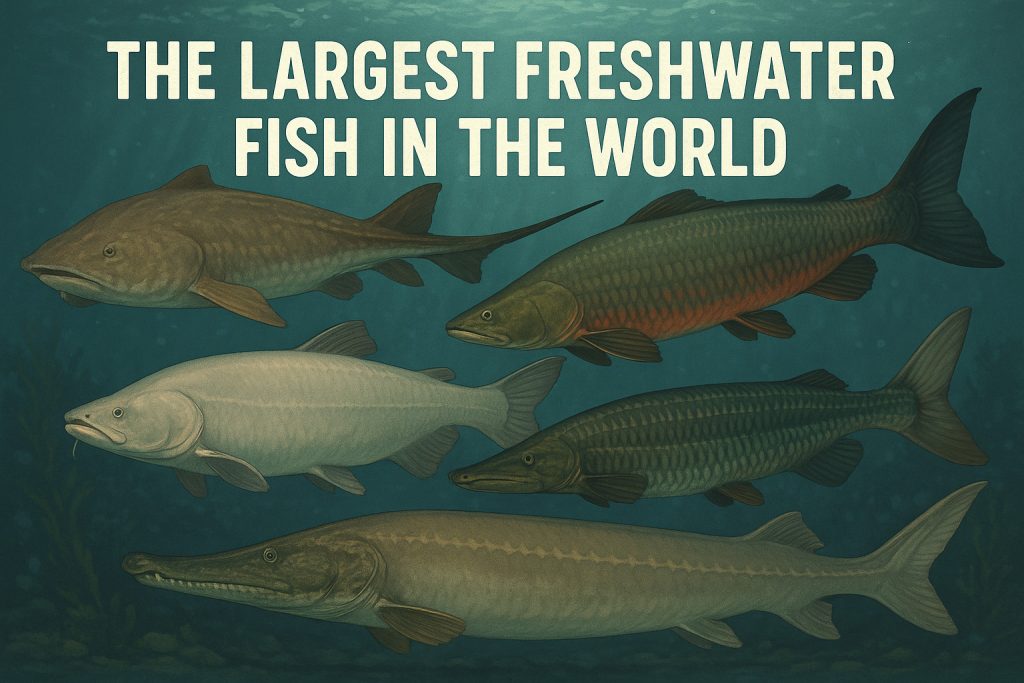Discover the largest freshwater fish in the world—giants like the stingray, arapaima, and sturgeon that rule rivers from the Amazon to the Mekong.
Rivers are not just flowing ribbons of water—they are home to some of the most colossal creatures on Earth. While oceans hold whales and sharks, rivers hide their own prehistoric titans. These are not legends—they are living, breathing giants that glide through murky currents, some the size of small boats. From Southeast Asia to the heart of the Amazon, the largest freshwater fish in the world represent both the mystery and majesty of inland waters.
But these behemoths face modern threats. Dams, pollution, and overfishing have driven many to the brink of extinction. Some, like the Chinese paddlefish, are already gone forever.
So which species are still out there? Which rivers do they call home? And how big can a freshwater fish truly get?
Let’s take a deep dive into the world’s great rivers to meet the true kings and queens of freshwater—ancient, endangered, and awe-inspiring.
🌏 RIVER TITANS: WHO’S THE BIGGEST?
🐋 1. Giant Freshwater Stingray (Urogymnus polylepis)
- Max Length: Up to 4 meters (13 feet)
- Weight: Up to 300–600 kg (660–1,300 lbs)
- Home Rivers: Mekong (Southeast Asia)
A flat-bodied leviathan with a venomous barb longer than your forearm, this is possibly the largest freshwater fish in the world by weight. In 2022, a 661-pound stingray was caught and released in Cambodia—marking a world record. Its sheer size and ghostly appearance evoke myth more than biology.
🐟 2. Mekong Giant Catfish (Pangasianodon gigas)
- Max Length: Up to 3 meters (10 feet)
- Weight: Over 300 kg (660 lbs)
- Home Rivers: Mekong River
Endemic to the Mekong, this gentle, scale-less giant is a plant-eating behemoth. Once revered across Southeast Asia, it’s now critically endangered due to overfishing, habitat loss, and dam construction. Its ghostly pale color and massive head have earned it both scientific fascination and cultural reverence.
🐉 3. Arapaima (Arapaima gigas)
- Max Length: Up to 4.5 meters (15 feet)*
- Weight: Over 200 kg (440 lbs)
- Home Rivers: Amazon and Essequibo Basins (South America)
(*Most specimens today are smaller due to overfishing)
A prehistoric predator wrapped in shimmering armor, the arapaima is one of the Amazon’s most iconic river dwellers. It surfaces regularly to breathe air—a quirk that makes it both fascinating and vulnerable. With bones older than most empires, it’s a living fossil of the rainforest.
🐊 4. Alligator Gar (Atractosteus spatula)
- Max Length: Up to 3 meters (10 feet)
- Weight: Up to 150 kg (330 lbs)
- Home Rivers: Mississippi River Basin (USA)
Looking like a blend of crocodile and fish, the alligator gar is a predator with armor-plated scales and twin rows of sharp teeth. Ancient and armored, it has survived multiple extinctions—and now enjoys a conservation-driven comeback.
🐟 5. Beluga Sturgeon (Huso huso)
- Max Length: Over 7 meters (23 feet)
- Weight: Up to 1,500 kg (3,300 lbs)
- Home Rivers: Danube, Volga, Caspian Sea tributaries
Technically a migratory fish that enters rivers to spawn, the beluga sturgeon is the heaviest freshwater fish in the world. This dinosaur-like creature can live for more than a century and has been overexploited for its prized caviar. Conservation efforts in Europe aim to bring it back from the brink.
🐟 6. Kaluga Sturgeon (Huso dauricus)
- Max Length: Over 5.5 meters (18 feet)
- Weight: 1,000 kg (2,200 lbs)
- Home Rivers: Amur River (Russia/China)
Known as the “river tsar,” this massive predator once ruled the cold, wild Amur. It’s one of the largest freshwater fish still swimming in the wild—though like its cousin, the beluga, it’s critically endangered.
🛑 CONSERVATION STATUS: MOST ARE IN DANGER
Sadly, nearly all of these river giants are threatened or endangered. Their habitats are vanishing beneath dams, their migratory routes are blocked, and many fall victim to overfishing, pollution, or climate change.
⚠️ Of the world’s 30 largest freshwater fish species, over 70% are declining. Some, like the Chinese paddlefish, are already extinct.
💧 WHY DO RIVERS HARBOR GIANTS?
Freshwater rivers may seem less vast than oceans, but they are ancient evolutionary corridors, supporting massive migratory routes, deep pools, and seasonal floods. These conditions once allowed giant fish to flourish—from Amazon floodplains to the deltas of Southeast Asia.
🧭 WHERE TO SEE THEM (RESPONSIBLY)
- Cambodia: Catch-and-release tourism for giant stingray in the Mekong
- Amazon Basin: Eco-tours near Iquitos or Manaus to spot arapaima
- USA: Gar conservation programs and aquariums
- Danube Delta or Volga Tributaries: Historical sturgeon habitats
Choose eco-certified tours, support sustainable fisheries, and always respect local conservation rules.
🌊 FINAL THOUGHT
The largest freshwater fish in the world are living testaments to our planet’s wild past—majestic, mysterious, and at risk. Protecting them means protecting the rivers they call home.
🧭 Explore more about endangered river life, river conservation, and the wild ecosystems these giants depend on—right here on WorldRivers.net.


